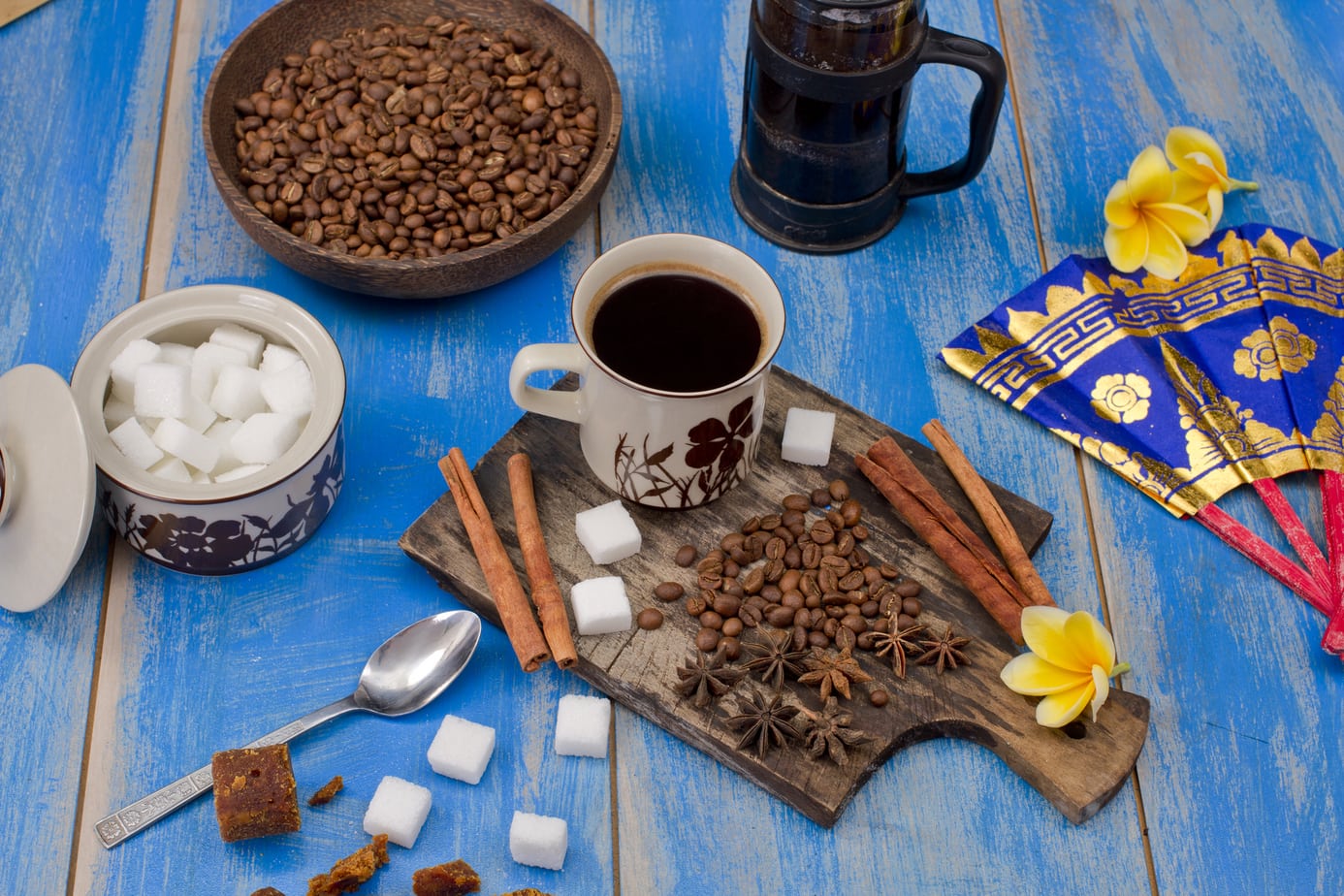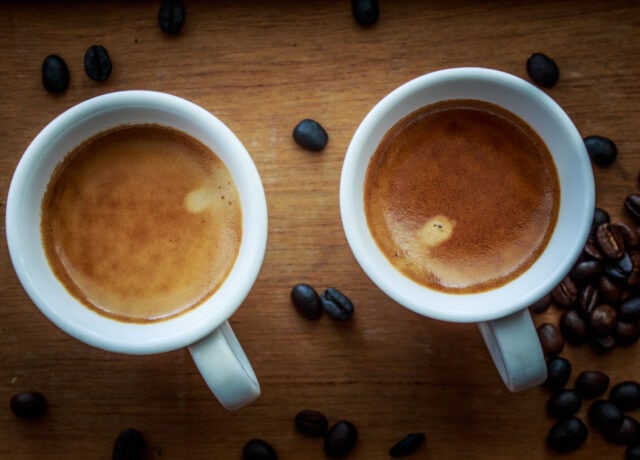Indonesia is an archipelago in Southeast Asia and is made up of a sprawling set of islands in the Oceania region. Being the largest archipelago in the world with thousands of islands, this incredible country has an intriguing history.
Their coffee industry has been at play for about 400 years now and is just as fascinating as the history of the country itself.
In this article we will discuss a brief history of the coffee industry in Indonesia, the current culture around their coffee, Indonesian coffee production, its common flavor profiles, and specific coffees to try.
At a Glance: Best Indonesian Coffee
The Brief History And Current Status
Indonesia’s coffee journey began when the Dutch colonized Indonesia in the latter part of the 17th century. They brought with them the Arabica coffee plant and began building coffee plantations starting on the island of Java.
As the Dutch East Indies (what is now known as the country of Indonesia) continued to develop its infrastructure, so did the coffee industry. This growth of infrastructure consequentially connected the islands more than they ever had been and coffee production spread across the islands.
After about a century of this exciting advancement, in the late 1800s, a disease known as Coffee Rust took out the Arabica coffee plant in most of the coffee plantations. With hopes of rebuilding the Indonesian coffee industry, the Dutch brought the Robusta coffee species to Indonesia due to its supposed resistance to disease.
Today, Indonesia continues to have a booming coffee industry led by family-owned farms and plantations. Most of the beans they use still come from the Robusta species, although the Arabica coffee species has recently been making a come back and is now prevalent in the specialty coffee scene.
Indonesia’s Java and Sumatra coffees are well known throughout the world, and many other wonderful coffees are coming from this country and circulating in the world today.
Quick Summary: Best Indonesian Coffee
 | Our Top Pick ANODYNE COFFEE DARK ROAST SUMATRA GAYO MANDIRI |
| Check Price → |
 | BROWNY INDONESIAN SUMATRA MANDHELING ORGANIC COFFEE |
| Check on Amazon → |
 | EQUATOR COFFEES JAVA ECHWAN SUYITNO NATURAL |
| Check Price → |
 | VOLCANICA 100% PURE SULAWESI COFFEE |
| Check on Amazon → |
 | SMOKIN BEANS COFFEE JAVA DUTCH ESTATE |
| Check on Amazon → |
 | THE BEAN COFFEE COMPANY MOCHA JAVA |
| Check on Amazon → |
Indonesian Coffee Production
Most coffee in the world is processed using a natural, washed, or wet process. Indonesia’s coffee production, however, relies on a process called Giling Basah. The term means “wet hulling” or “wet grinding”.
The Giling Basah process has similarities to the washed process in which coffee cherries are de-pulped and washed before drying, and also to the natural process where they are dried as they are after picking.
This Indonesian practice begins as a natural process as the beans are left to dry for a few days after picking. After a few days, the cherries are slightly dried but still hold 30-50% moisture in them and are then sent through the hulling machine that de-pulps and washes the cherries. The beans are then left to dry on patios for a few more days.
Giling Basah promotes specific characteristics in the coffees it produces. Due to the amount of time, the cherries were left to dry with the pulp still intact, juicy, fruity, earthy, and spicy flavors are enhanced in the coffee beans that remain.

Growing Conditions and Challenges
Indonesia is a very humid country. This humidity affects the coffee production process as it contributes to the amount of moisture in the coffee beans.
The Giling Basah process essentially expedites the coffee production process for farmers to get money for their beans sooner than later, and also provides the most efficient system for drying the coffee beans in such a humid climate.
If the farmers were to use a natural process of drying the cherries out, it would take a longer time than preferred due to the constant high humidity. Wet hulling is the most practical option for Indonesian coffee farmers.
Growing Regions
Here are just a few of the most popular coffee-producing Indonesian islands with brief descriptions.
Sumatra
Sumatra is the farthest northwestern island in Indonesia. This causes their harvest season to be earlier compared to the other coffee-producing islands from November to March. Making up a huge percentage of Robusta coffee production in Indonesia, Sumatra is home to several different growing regions and varieties of Indonesian coffee.
When you hear about coffee from Sumatra, you often hear about Mandheling coffee or region. The name originated from the name of an ethnic group in Indonesia. It is known to be one of the most full-bodied coffees in the world and can be described as smooth and syrupy.
The other two main Sumatran varieties are Gayo and Lintong. The Gayo variety is a dense bean packed with strong and intense flavor. The Lintong variety produces a pleasant combination of full flavor with a clean and crisp taste as well.
Java
The island of Java is situated in the most southwestern corner of the Indonesian archipelago is the oldest Indonesian coffee-producer. It has a whole lot of history about it which translates to the fact that everybody has probably tried Java coffee beans before.
The harvest season for Java coffees is June to October and has to do with the high plateaus the plants are grown on.
When the devastating coffee rust hit Java in the latter part of the 19th century, farmers had to move their crops to higher ground. This move surprisingly created better quality coffee.
You might have heard of Mocha Java coffee before. Being one of the first coffee blends in the world, Mocha Java came from the mixing of Java coffee and “Mokha” coffee from Yemen. This blend was created when trading ships passed to a from each country, and, eventually resulted in the blending of the two.
Typical tasting notes you will find in Java coffees have similarities to the complex Sumatran coffees in that they are syrupy, full-bodied, and have mellow acidity. However, Java tends to be more clean and sweet than Sumatran coffees.

Sulawesi
Located in the northern-central region of Indonesia, the island of Sulawesi was one of the later recipients of the coffee plant. The Sulawesi coffee variety is also known as “Toraja coffee.” The harvest season for Toraja coffee is usually May to November and has some of the highest growing coffee in Indonesia.
Sulawesi coffees tend to be a bit more simple and lighter in body and flavor than other Indonesian coffees. It’s flavor profile usually includes the same syrupy flavor and low acidity that you find in most Indonesian coffees but tends to not be quite as earthy. Toraja coffee is often described as having a clean flavor and has warm, spicy, nutty, and dark chocolate notes.
Indonesian Coffee Flavor Profile
As you have gathered from previous descriptions in this article, Indonesian coffees tend to be full-bodied, have a syrupy mouthfeel, are dense, and have low acidity.
We previously mentioned just a few coffee-growing regions in Indonesia, and you can see that there are differences between the products coming from these regions. So, along with those across-the-board characteristics of Indonesian coffees, each region has its own unique flavor.
You might hear that Indonesian coffee tends to be good as dark roasts. The beans, as mentioned previously, are often quite dense.
This makes them good candidates for a longer roast (the longer they roast, the darker the beans become) because, essentially, they have a lot of density to lose, so they can be roasted longer. A darker roast of Indonesian coffee brings out its bold characteristics, emphasizing the dark chocolate, warm flavors, spices, and earthiness.
Coffee Worth Trying
Choosing which bag of delicious beans to buy for your daily coffee habit can be a tough decision. There are so many options out there with so many different wonderful characteristics.
Narrowing down your options is possible, but if you have now decided to try out some Indonesian coffee beans, then half the battle is already won. Here are a few recommendations for you to check out.
Anodyne Coffee Dark Roast Sumatra Gayo Mandiri

Anodyne Coffee Dark Roast Sumatra Gayo Mandiri
A slightly earthy, chocolaty sweetness complements the hint of roastiness in this classic Sumatran cup.
In typical Indonesian coffee fashion, Anodyne Coffee’s Gayo Mandiri coffee is dark and roasty. The sweet flavors, courtesy of the dark chocolate tasting notes, complements that intensity well, and that’s why these beans landed a spot on our list of Sumatran coffee recommendations.
These beans are processed using the wet-hulling process that’s traditional of Sumatra; this mitigates the risk of the coffee getting oversaturated in the region’s random spurts of rain. The end result is a rich brew that will bring a smile to your face every time you pour yourself a cup of the stuff.
Browny Indonesian Sumatra Mandheling Organic Coffee
This dark roast, fair trade, organic Sumatra Mandheling coffee is true to its roots with its rich flavor and full body. These beans are roasted in Queens, NY by the Browny Coffee.
The region where this coffee is grown is rich in volcanic soil and has a warm tropical climate which helps to further develop the flavors of the beans. Earthy, herbaceous, and vibrant are good words to describe this delicious coffee.
Equator Coffees Java Echwan Suyitno Natural

Equator Coffees Java Echwan Suyitno Natural
Candied fruit meets a deep cherry cola sweetness in this certifiably fun cup.
A cup of this joe from Equator Coffees is a fun and delicious way to kick off your day. It’s got all the intensity you expect from Indonesian brew while hints of candied fruit give it an undeniable sweetness we think you’ll really get a kick out of. As you sip, see what other notes you can pluck out of this java — there are flavors of lychee, blackberry, cinnamon, and cashews, too!
This bag of beans, named Java Echwan Suyitno Natural, was grown in East Java and produced by Pak Echwan. Then, the coffee makes its way to California where Equator Coffees roasts it to light perfection. Try using a manual brewing method, like a pour-over, to fully experience the fruits of the roaster’s labor. Trust us…it’s good.
Volcanica 100% Pure Sulawesi Coffee
Similar to the Browny Sumatra coffee, this coffee is also grown in volcanic regions which provides rich nutrients to the soil and therefore to the beans as well. Volcanica Coffee Company is unique in that all of their coffees come from these volcanic regions, hence the clever name.
This coffee is 100% of the Arabica species whose trees are over 250 years old. These beans are a little bit lighter than Sumatra beans in body and aroma. The medium roast also plays into the lighter feel and flavors of this coffee.
Smokin Beans Coffee Java Dutch Estate
When you go to purchase these beans, you get to choose how much you want your beans roasted and they will roast it fresh for you. You can choose anywhere from a light roast to a dark Italian roast. Perhaps you can use what you learned from this article to determine what roast might complement your Java Indonesian coffee beans the most.
These 100% Arabica coffee Java beans have flavor emphasis on cloves and cinnamon. They have a rich body and low acidity, typical of Indonesian coffee beans. This would be a fun coffee to try for at-home brewing because you get to control the roast, too.
The Bean Coffee Company Mocha Java
The Bean Coffee Company’s Mocha Java blend is a perfect embodiment of the Mocha Java blend we discussed previously. This Indonesian coffee is complex and has a full body, but this intensity is complemented well by some acidity, making it taste fresh and aromatic.
The Bean Coffee Company is careful with each batch of coffee, roasting them in small quantities so they can have the best results possible. They are a company that cares deeply for the beans they are handling and desire to get the best possible outcome for their consumers.
The Wrap Up
Indonesian coffee has a long and well-established history. Even though you have probably experienced a dark Java roast, there is still room to explore more with Java Sulawesi, Toraja coffee or Indonesian coffee from Sumatra, to taste its dark chocolate, smooth and earthy flavor.
We hope that you have gained some Indonesian coffee knowledge that you can now take with you on your coffee journey. Try one, or maybe a few, of those suggestions and remember to enjoy your morning cup of joe!
Happy sipping!











